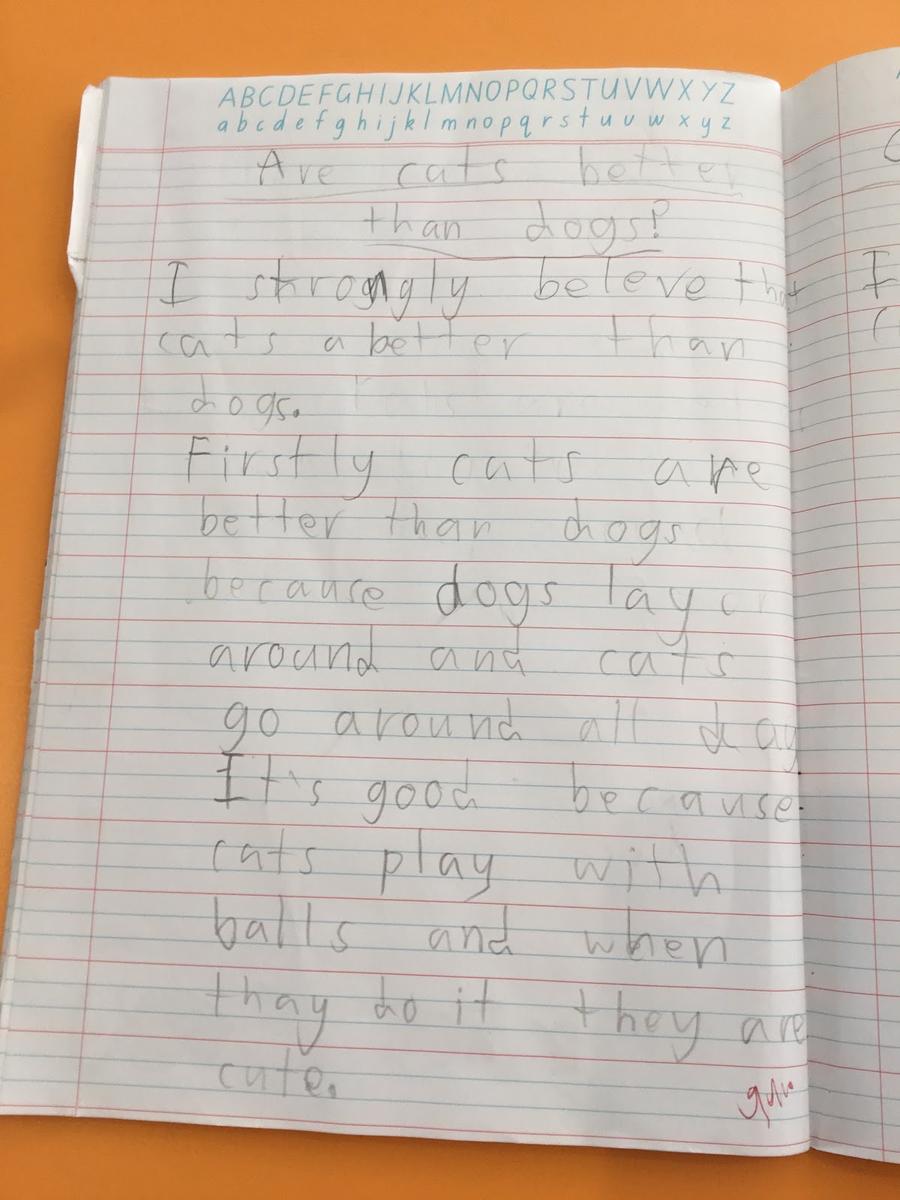
Yr 6 Newsletter Committee
Kindergarten
KJ
Last week KJ have been learning about Fairy Tales in English so that their class can speak and write using more words that describe Fairy Tales. KJ learnt about Fairy Tales inside their classroom; a habit of mind that Hugo uses when learning about Fairy Tales is Responding with Wonderment and Awe. A habit of mind that Thomas uses when learning about Fairy Tales is Thinking Flexibly so that he can think and work out what might happen next in the fairy tale. A highlight for Thomas is getting to write a story that he already knows and loves, whilst Hugo’s highlight is listening to great stories.
By Jamie Z
KM
This week in English, KM have been learning how to write imaginative texts, by being able to illustrate and write fairy tales. The last fairy tale KM have written about was the ‘little red riding hood.’ Two children in KM were asked what habit they used and Harry and Keon thought they would've used the ‘thinking flexibly’ the most. Keon and Harry thought this because when they had to create their own story Harry and Keon had to think outside of the box and be inspired by different fairy tales. Harry chose to construct a pirate fairy tale and Keon decided to create a ninja fairy tale. Keon’s favorite fairy tale is Fumblina and Harry’s is Hansel and Gretel. The two of them both enjoyed writing about fairy tales and hope to produce more in the future!
By Ella V
Year 1
1J
Dogs are way better than cats! This week 1J have been exploring persuasive texts, sizzling starters and the Oreo pragraph technique which stands for opinion, reasons, examples and opinion. Ned in 1J has been preparing for a writing task this week by reading the precise success criteria to write a descriptive persuasive text. Finally…. dogs are way better than cats according to some students in 1J. Do you agree?
By Josh B
1M
Last week in English 1M have been exploring the wonderful world of persuasive text! Using the OREO and PIE text structure, they chose one of the many persuasive text topics that included: ‘Superheroes are Brave, ‘Dragons are Dangerous’, ‘Pirates are Mean’ and ‘Cats or Dogs’. Celie wrote a persuasive text on the topic dragons are dangerous and Flynn wrote one on Superheros are Brave. They both really enjoyed last weeks English and can not wait to write some more persuasive texts!
By Jessica H
Year 2
2M
‘This week in English we have been doing persuasive writing. We can choose our own topics and I have to use persisting because if I don’t know some examples to support my points I have to keep trying and not give up.’ Explains Roxy and Cian. ‘We also have to follow the structure if OREO. Which stands for OPINION, REASONS, EXAMPLES, OPINION. I love it!’
By Issy.W
2J
2J have been learning about persuasive texts. Their topic was that ‘Children Should Have More Recess Time’. 2J have been learning about the language to use and devices to use when writing a persuasive text. How they write their paragraph structure is: Opinion, Sequence, and cause and effect. Some language that they are trying to use is: strongly, I believe, definitely, absolutely and in addition. 2J love learning about persuasive texts and trying to persuade an audience!!
By Fionn C
Are Cats Better than dogs? By Evan Stavrou
Year 3
3J
In year 3J last week they did 30 second speeches on whatever topic they wanted. The goal of the speech was to practice their eye contact, projection and pace. Also in writing they have started learning about fixed fairy tales. In the fixed fairy tale unit they will also be looking at descriptive language. Torah and Aubrey are looking forward to this unit and improving their writing skills to engage and entertain an audience.
By Nicholas T-P
3M
Jump, run, kick, have fun, sport keeps you active.” Vivianna sang to the class during her speech. The whole class applauded as Vivi finished her speech! 3M have been writing speeches and focusing on the topic ‘Public Speaking’. Jedd used the HoM managing impulsivity because he had to try his best to not fiddle. Vivi has to strive for accuracy when creating her speech because she had to make sure it made sense, otherwise no one would listen. The goal of these speeches was to practice eye contact, pace and voice projection. 3M have enjoyed the topic on public speaking.
By Eleni C
Year 4
4M
In English, 4M have been learning a number of things. They have been learning about the 4 step strategy and how to locate definitions and synonyms in a dictionary. The 4 step strategy consists of 4 steps to gain more meaning in the text and to understand difficult words. The first step is to monitor; make sure you understand the text. The second step is slow advance, remember to read over the text slowly. The third step is to look for context clues, if you run into a difficult word read the sentences around the words. The fourth and final step is substitute meaning replace the word with an alternate word. 4M have also been investigating how to use a dictionary while looking for synonyms to replace unfamiliar words. They have also been using the reading comprehension strategy summarising while reading the text ‘Bartlet and the Forest of Plenty’ to find juicy vocabulary. Any difficult words get written onto to the juicy word tree, then 4M gets asked to pick 5 juicy words to use in their writing to bump it up. Nathen N and Isaac M both commented that they are both enjoying literature circles as they have only just started.
By Steph
4J
This week during english 4J have been completing Y charts on a photo of a robot and/or human before the photo was taken, during the photo was taken and after the photo was taken. Xavier commented that the most enjoyable part of English this week was writing his speech on climate change and getting it ready to present to his class. A habit of mind Charlotte has had to use this week is persistence during speech writing because things can go wrong when you present your speech and you need to keep going.
By Cara M
Year 5
5J
In English, 5J have been learning the 4 step strategy (play and question, slow advance, stop and rewind, play and question). They have been finding unknown in personal texts and the class serial reading text, ‘The Burnt Stick’, which they recently finished. While writing they have focusing on informative texts, using the ‘Bump it Up Wall’ to help make their work WOW.
By India C
5M
“What does that word in the poster mean?”
“How can this be Bumped Up?”
5M have been diving deep into text and finding the real meaning of certain songs like Bruno Mars’ Just The Way You Are and others. 5M have enjoyed this and love to do this during English. This term 5M have continued using the inference equation and doing reciprocal teaching. 5M have been reading Kensukue’s Kingdom and just love the book. 5M have been doing lots these past few weeks and are excited to do even more in the future.
By Aleya C
Year 6
This week year Six have been learning how to write biographies, learning the aspect of bias, revising punctuation skills and using Narrative Pyramids to purposefully select varied vocabulary that demonstrates a deeper meaning of the story. Recently the Year Six students have taken trips to the Woonona IRT and in groups have interviewed their person/ resident, asking meaningful questions and gathering information to write a biography about them. Bias means that a person has an inclination or prejudice for or against an idea or person; so far students in Year Six have read texts to highlight the language features that have been purposefully used to create bias. They have also been revising punctuation because it is a skill that can easily be forgotten. Last term year six delved into the topic of inferential reading ‘using the hidden clues in the texts and linking it with prior knowledge to find the metaphorical meaning.’ Now Year Six is using Narrative pyramids to unpack the sophisticated language used in their class serial reader ‘A Single Shard.’ The purpose of this system is to make us use the sophisticated language in our everyday writing and speech.
By Sophie B




